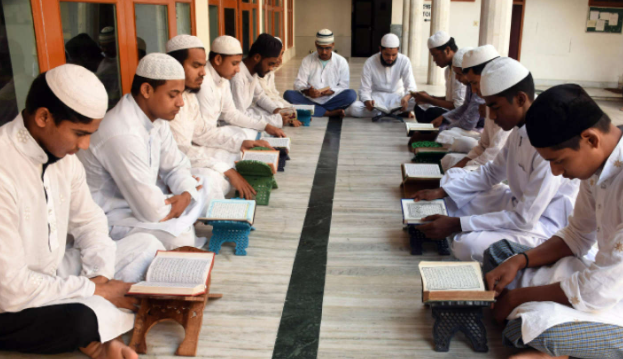The Role of Madrasas in the Indian Education System (GS Paper 2, Education)

Introduction
- Madrasas, derived from the Arabic term for "school," are pivotal educational institutions primarily associated with Islamic teachings.
- While they have historically focused on religious education, their role in the broader educational framework in India has evolved, making them significant players in fostering literacy, cultural identity, and social cohesion within Muslim communities.
Historical Context
- The educational tradition of madrasas dates back to the formative centuries of Islam.
- In these early times, mosques served as primary centers for learning, where religious and secular knowledge was imparted.
- By the 10th century, madrasas began to emerge as distinct institutions, particularly in regions like Khorasan and Transoxania, which now encompass parts of modern-day Iran and Central Asia.
- In India, madrasas have played a crucial role in preserving Islamic teachings and promoting literacy, particularly in areas with limited access to formal schooling.
Current Status of Madrasas in India
- According to data from 2018-19, India boasts around 24,010 madrasas.
- Uttar Pradesh is home to the largest concentration, with 11,621 recognized madrasas.
- Recognized madrasas operate under state madrasa education boards, while unrecognized institutions may follow curricula set by prominent seminaries such as Darul Uloom Deoband.
- The role of madrasas has been scrutinized in recent years, particularly with the National Commission for Protection of Child Rights (NCPCR) raising concerns about the adequacy of their educational offerings in relation to the Right to Education (RTE) Act.
Educational Curriculum and Structure
Madrasas in India are primarily categorized into two types:
- Madrasa Darse Nizami: These operate as public charitable institutions and are not bound by state education curricula. They focus on religious studies alongside some secular subjects.
- Madrasa Darse Aliya: These are affiliated with state madrasa education boards and are required to adhere to a regulated curriculum that includes core subjects like Mathematics, Science, Hindi, and English, in addition to Islamic studies.
Students progress through various levels of education, achieving qualifications that parallel mainstream education systems. The highest levels include Kamil (equivalent to a Bachelor's degree) and Fazil (equivalent to a Master's degree).
Challenges Facing Madrasas
While madrasas serve as vital educational institutions, they encounter several challenges:
- Quality of Education: Many madrasas struggle with inadequate resources, insufficiently trained teachers, and outdated curricula. This often leads to poor educational outcomes, reflected in lower literacy rates among graduates compared to those from mainstream schools.
- Social Integration: Graduates of madrasas frequently find it difficult to integrate into the broader workforce. The traditional focus on religious studies can result in a lack of vocational skills and practical knowledge, leaving many students ill-prepared for modern job markets.
- Accreditation and Regulation: The absence of a standardized accreditation process for madrasas raises concerns about educational quality and uniformity. Without regulatory oversight, disparities in educational standards can arise, undermining the credibility of madrasas.
The Role of Government and Funding
Government support plays a crucial role in the functioning of madrasas. Initiatives like the Scheme for Providing Education to Madrasas/Minorities (SPEMM) aim to enhance educational quality and infrastructure. This scheme has two main components:
- Scheme for Providing Quality Education in Madrasas (SPQEM): Focused on improving educational standards, this program seeks to modernize curricula and teacher training.
- Infrastructure Development of Minority Institutes (IDMI): Aimed at enhancing the physical facilities of madrasas, ensuring that they meet basic educational requirements.
Despite these efforts, there are criticisms regarding the equitable allocation of resources. Some argue that public funding for religious education raises questions about secularism and equality in the education system. Ensuring that all religious groups receive equitable support is crucial for maintaining fairness in educational opportunities.
Future Directions
To enhance the effectiveness of madrasas within the Indian education system, several strategic initiatives can be pursued:
- Vocational Training: Incorporating vocational education into the madrasa curriculum can equip students with practical skills, enabling them to compete effectively in the job market. This could involve partnerships with local industries to provide hands-on training and internships.
- Quality Assurance: Establishing regulatory frameworks and accreditation systems is essential to ensure that madrasas meet modern educational standards. Regular assessments and evaluations can help maintain quality and consistency across institutions.
- Equitable Funding: Implementing fair funding policies that support all educational institutions, regardless of religious affiliation, will ensure that public resources enhance educational quality and infrastructure without promoting specific religious ideologies.
- Community Engagement: Engaging parents, community leaders, and non-governmental organizations (NGOs) can foster awareness about the importance of holistic education. Community programs can promote the value of formal schooling alongside religious education, encouraging families to prioritize comprehensive education for their children.
Conclusion
- Madrasas hold a significant place in the Indian education system, particularly for Muslim communities.
- They serve not only as centers of religious education but also as platforms for cultural preservation and literacy.
- By addressing the challenges they face and implementing strategic reforms, madrasas can contribute more effectively to social integration and educational advancement in India.
- Balancing religious teachings with modern academic and vocational training is essential for equipping students to thrive in a rapidly changing world, thereby promoting upward mobility and fostering greater social cohesion.


